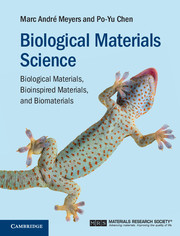Book contents
- Frontmatter
- Epigraph
- Contents
- Preface
- List of Boxes
- 1 Evolution of materials science and engineering: from natural to bioinspired materials
- Part I Basic biology principles
- Part II Biological materials
- Part III Bioinspired materials and biomimetics
- 12 Bioinspired materials: traditional biomimetics
- 13 Molecular-based biomimetics
- References
- Index
13 - Molecular-based biomimetics
from Part III - Bioinspired materials and biomimetics
Published online by Cambridge University Press: 05 August 2014
- Frontmatter
- Epigraph
- Contents
- Preface
- List of Boxes
- 1 Evolution of materials science and engineering: from natural to bioinspired materials
- Part I Basic biology principles
- Part II Biological materials
- Part III Bioinspired materials and biomimetics
- 12 Bioinspired materials: traditional biomimetics
- 13 Molecular-based biomimetics
- References
- Index
Summary
Introduction
The quest to mimic nature is now reaching a new chapter. Whereas in the past, structural and functional characteristics served as inspiration for designs and materials, with attention given to mesoscopic and, perhaps, microscopic aspects, the arsenal of new experimental techniques and computational methods is descending to the nanometer scale. This is the scale at which atoms assemble into molecules, and molecules form molecular arrangements such as DNA, RNA, plasmids, and proteins.
Prominent characterization techniques available to modern researchers are (e.g. Gronau et al., 2012):
transmission and scanning electron microscopy at higher and higher resolutions;
micro and nano computerized tomography;
atomic force microscopy;
fluorescence spectroscopy;
Fourier transform infrared spectroscopy (FTIR);
dynamic light scattering;
X-ray diffraction.
small-angle X-ray scattering (SAXS);
nanomechanical testing (nanoindentation);
The principal computational methods are:
density functional theory (DFT);
quantum-mechanical and ab initio methods;
coupled cluster method (CCSD);
reactive and nonreactive molecular dynamics;
coarse graining;
finite element method;
computational fluid mechanics.
- Type
- Chapter
- Information
- Biological Materials ScienceBiological Materials, Bioinspired Materials, and Biomaterials, pp. 560 - 583Publisher: Cambridge University PressPrint publication year: 2014



